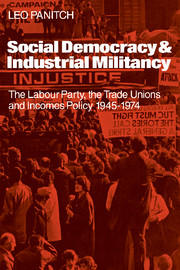 Social Democracy and Industrial Militiancy
Social Democracy and Industrial Militiancy Book contents
- Frontmatter
- Contents
- Preface
- List of Abbreviations
- Introduction
- 1 The 1945 Labour Government: the mixed economy and wage restraint
- 2 Incomes policy and Labour in opposition
- 3 The voluntary incomes policy agreement
- 4 The devaluation of voluntarism
- 5 The politics of wage freeze
- 6 The statutory incomes policy – Labour Government versus labour movement
- 7 ‘In place of strife’
- 8 Industrial militancy and political stagnation
- Conclusion
- Appendixes
- Notes
- Index
6 - The statutory incomes policy – Labour Government versus labour movement
Published online by Cambridge University Press: 07 October 2011
- Frontmatter
- Contents
- Preface
- List of Abbreviations
- Introduction
- 1 The 1945 Labour Government: the mixed economy and wage restraint
- 2 Incomes policy and Labour in opposition
- 3 The voluntary incomes policy agreement
- 4 The devaluation of voluntarism
- 5 The politics of wage freeze
- 6 The statutory incomes policy – Labour Government versus labour movement
- 7 ‘In place of strife’
- 8 Industrial militancy and political stagnation
- Conclusion
- Appendixes
- Notes
- Index
Summary
The 1967 legislation: ‘C'est seulement le provisiore qui dure …’
A fundamental problem facing any Government which has imposed a wage freeze is to guard against a compensatory wage explosion in the following period. To the Labour Government in 1967, this problem was particularly acute in that its entire economic strategy was predicated upon securing a stable balance of payments surplus by early 1968. Thus while an overall surplus in the last quarter of 1966 convinced Ministers that ‘the corner had been turned’, it was clear that an extensive relaxation of wage restraint and deflation could have the effect of upsetting the fragile renewal of confidence in the future of the pound's stability. Callaghan's ‘steady as she goes’ April budget saw the contribution of incomes policy as that of keeping the growth of wages to 6% over 1967 as a whole, but a new White Paper in March retained the ‘nil’ norm (lest any figure above zero might be seen by the unions as a minimum due to them after the freeze and severe restraint) with any increase having to be justified on the grounds of the four exceptions in the original policy. On prices and dividends, on the other hand, there was a complete return to the prefreeze policy. Callaghan told the House in April of the Government's desire to see ‘a recovery from the present low level of profitability’, and he pledged: ‘I have no intention of killing the goose that lays the golden eggs.’
- Type
- Chapter
- Information
- Social Democracy and Industrial MilitiancyThe Labour Party, the Trade Unions and Incomes Policy, 1945–1947, pp. 140 - 164Publisher: Cambridge University PressPrint publication year: 1976


